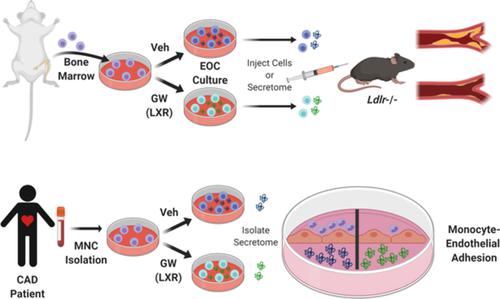当前位置:
X-MOL 学术
›
Stem Cells Transl. Med.
›
论文详情
Our official English website, www.x-mol.net, welcomes your feedback! (Note: you will need to create a separate account there.)
The secretome of liver X receptor agonist‐treated early outgrowth cells decreases atherosclerosis in Ldlr−/− mice
STEM CELLS Translational Medicine ( IF 6 ) Pub Date : 2020-11-24 , DOI: 10.1002/sctm.19-0390 Adil Rasheed 1 , Sarah A Shawky 1 , Ricky Tsai 1 , Richard G Jung 2, 3, 4 , Trevor Simard 2, 3, 4, 5 , Michael F Saikali 1 , Benjamin Hibbert 2, 3, 4, 5 , Katey J Rayner 4, 6 , Carolyn L Cummins 1, 7, 8
STEM CELLS Translational Medicine ( IF 6 ) Pub Date : 2020-11-24 , DOI: 10.1002/sctm.19-0390 Adil Rasheed 1 , Sarah A Shawky 1 , Ricky Tsai 1 , Richard G Jung 2, 3, 4 , Trevor Simard 2, 3, 4, 5 , Michael F Saikali 1 , Benjamin Hibbert 2, 3, 4, 5 , Katey J Rayner 4, 6 , Carolyn L Cummins 1, 7, 8
Affiliation

|
Endothelial progenitor cells (EPCs) promote the maintenance of the endothelium by secreting vasoreparative factors. A population of EPCs known as early outgrowth cells (EOCs) is being investigated as novel cell‐based therapies for the treatment of cardiovascular disease. We previously demonstrated that the absence of liver X receptors (LXRs) is detrimental to the formation and function of EOCs under hypercholesterolemic conditions. Here, we investigate whether LXR activation in EOCs is beneficial for the treatment of atherosclerosis. EOCs were differentiated from the bone marrow of wild‐type (WT) and LXR‐knockout (Lxrαβ−/−) mice in the presence of vehicle or LXR agonist (GW3965). WT EOCs treated with GW3965 throughout differentiation showed reduced mRNA expression of endothelial lineage markers (Cd144, Vegfr2) compared with WT vehicle and Lxrαβ−/− EOCs. GW3965‐treated EOCs produced secreted factors that reduced monocyte adhesion to activated endothelial cells in culture. When injected into atherosclerosis‐prone Ldlr−/− mice, GW3965‐treated EOCs, or their corresponding conditioned media (CM) were both able to reduce aortic sinus plaque burden compared with controls. Furthermore, when human EOCs (obtained from patients with established CAD) were treated with GW3965 and the CM applied to endothelial cells, monocyte adhesion was decreased, indicating that our results in mice could be translated to patients. Ex vivo LXR agonist treatment of EOCs therefore produces a secretome that decreases early atherosclerosis in Ldlr−/− mice, and additionally, CM from human EOCs significantly inhibits monocyte to endothelial adhesion. Thus, active factor(s) within the GW3965‐treated EOC secretome may have the potential to be useful for the treatment of atherosclerosis.
中文翻译:

肝脏 X 受体激动剂处理的早期生长细胞的分泌组可降低 Ldlr-/- 小鼠的动脉粥样硬化
内皮祖细胞 (EPC) 通过分泌血管修复因子促进内皮细胞的维持。一群被称为早期生长细胞 (EOC) 的 EPC 正在被研究作为治疗心血管疾病的新型细胞疗法。我们之前证明,肝脏 X 受体 (LXR) 的缺失不利于高胆固醇血症条件下 EOC 的形成和功能。在这里,我们研究 EOC 中的 LXR 激活是否有利于动脉粥样硬化的治疗。在载体或 LXR 激动剂 (GW3965) 存在下, EOC 与野生型 (WT) 和 LXR 敲除 ( Lxrαβ -/-) 小鼠的骨髓不同。在整个分化过程中用 GW3965 处理的 WT EOC 显示内皮谱系标志物的 mRNA 表达降低。Cd144 , Vegfr2 ) 与 WT 载体和Lxrαβ -/- EOCs 相比。GW3965 处理的 EOC 产生分泌因子,可减少单核细胞与培养中活化的内皮细胞的粘附。当注射到易患动脉粥样硬化的Ldlr -/- 小鼠中时,与对照组相比,GW3965 处理的 EOC 或其相应的条件培养基 (CM) 都能够减少主动脉窦斑块负荷。此外,当用 GW3965 治疗人类 EOC(从确诊 CAD 患者获得)并将 CM 应用于内皮细胞时,单核细胞粘附减少,表明我们在小鼠中的结果可以转化为患者。因此,EOCs 的离体 LXR 激动剂治疗产生了减少Ldlr早期动脉粥样硬化的分泌组-/- 小鼠,此外,来自人类 EOC 的 CM 显着抑制单核细胞与内皮的粘附。因此,GW3965 处理的 EOC 分泌组中的活性因子可能对治疗动脉粥样硬化有用。
更新日期:2020-11-24
中文翻译:

肝脏 X 受体激动剂处理的早期生长细胞的分泌组可降低 Ldlr-/- 小鼠的动脉粥样硬化
内皮祖细胞 (EPC) 通过分泌血管修复因子促进内皮细胞的维持。一群被称为早期生长细胞 (EOC) 的 EPC 正在被研究作为治疗心血管疾病的新型细胞疗法。我们之前证明,肝脏 X 受体 (LXR) 的缺失不利于高胆固醇血症条件下 EOC 的形成和功能。在这里,我们研究 EOC 中的 LXR 激活是否有利于动脉粥样硬化的治疗。在载体或 LXR 激动剂 (GW3965) 存在下, EOC 与野生型 (WT) 和 LXR 敲除 ( Lxrαβ -/-) 小鼠的骨髓不同。在整个分化过程中用 GW3965 处理的 WT EOC 显示内皮谱系标志物的 mRNA 表达降低。Cd144 , Vegfr2 ) 与 WT 载体和Lxrαβ -/- EOCs 相比。GW3965 处理的 EOC 产生分泌因子,可减少单核细胞与培养中活化的内皮细胞的粘附。当注射到易患动脉粥样硬化的Ldlr -/- 小鼠中时,与对照组相比,GW3965 处理的 EOC 或其相应的条件培养基 (CM) 都能够减少主动脉窦斑块负荷。此外,当用 GW3965 治疗人类 EOC(从确诊 CAD 患者获得)并将 CM 应用于内皮细胞时,单核细胞粘附减少,表明我们在小鼠中的结果可以转化为患者。因此,EOCs 的离体 LXR 激动剂治疗产生了减少Ldlr早期动脉粥样硬化的分泌组-/- 小鼠,此外,来自人类 EOC 的 CM 显着抑制单核细胞与内皮的粘附。因此,GW3965 处理的 EOC 分泌组中的活性因子可能对治疗动脉粥样硬化有用。



























 京公网安备 11010802027423号
京公网安备 11010802027423号